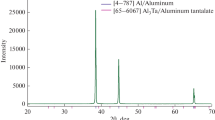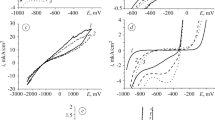Abstract
The electrical resistivities of aluminum alloys containing Cu, Ge, Zn, Ag, Cd, and Mg were found to increase linearly with the atomic percentage of the solute atoms. Application of Linde’s rule to these data suggests that each aluminum atom contributes 2.5 electrons to the metallic bond.
Similar content being viewed by others
References
W. Hume-Rothery: The Structure of Metals and Alloys. Inst, of Metals, Monograph and Report Series No. 1 (1947) p. 34.
Metals Handbook (1948) p. 21, ASM. Cleveland.
M. N. Ageev and D. L. Ageeva: Experimental Determination of the Electron Density in Aluminum. Bull. Acad. Sc. Chim. (1948) pp. 17–28.
W. Hume-Rothery and G. V. Raynor: The Apparent Sizes of Atoms in Metallic Crystals with Special Reference to Aluminum and Indium and the Electronic State of Magnesium. Proc. Royal Society, London (1941) 177, pp. 27–37.
W. Hume-Rothery: Atomic Theory for Students of Metallurgy. Inst, of Metals, Monograph and Report Series No. 3 (1947) p. 213.
J. E. Dorn, P. Pietrokowsky and T. E. Tietz: The Effect of Alloying Elements on the Plastic Properties of Aluminum Alloys. Fifth Technical Report to Office of Naval Research under Contract N7-ONR-295, Task II (Aug. 1949).
J. E. Dorn, P. Pietrokowsky and T. E. Tietz: The Effect of Alloying Elements on the Plastic Properties of Aluminum Alloys. Trans. AIME (1950) 188, p. 933; Journal of Metals (July 1950).
A. L. Norbury: The Electrical Resistivity of Dilute Metallic Solid Solution. Trans. Faraday Soc. (1921) 16, p. 570.
J. O. Linde: Elektrische Eigenschaften verdiinnter Mischkristallegierungen I. Goldlegierungen. Ann. d. Physik (1931) 10, p. 52.
J. O. Linde: Elektrische Eigenschaften verdünnter Mischkristallegierungen II. Widerstand von Silberlegierungen. Ann. d. Physik (1932) 14, p. 353.
J. O. Linde: Elektrische Eigenschaften verdünnter Mischkristallegierungen III. Widerstand von Kupfer- und Goldlegierungen, Gesetzmassigkeiten der Widerstandserhohungen. Ann. d. Physik (1932) 15, p. 219.
N. F. Mott and H. Jones: The Theory of the Properties of Metals and Alloys, p. 292 (1936) Oxford. Clarendon Press.
N. F. Mott: The Electrical Resistance of Dilute Solid Solutions. Proc. Camb. Phil. Soc. (1936) 32, p. 281.
A. Matthiessen and C. Vogt: Ueber den Einfluss der Temperatur auf die elektrische Leitungsfahigkeit der Legirungen. Annalen der Physik und Chemie (1864) 122, p. 19.
P. 810 of ref. 2.
Author information
Authors and Affiliations
Additional information
Discussion on this paper, TP 3066E, may be sent, 2 copies, to AIME by Aug. 1, 1951. Manuscript, Dec. 18, 1950; revision, March 16, 1951. Detroit Meeting, October 1951.
Rights and permissions
About this article
Cite this article
Robinson, A.T., Dorn, J.E. Effect of Alloying Elements on the Electrical Resistivity of Aluminum Alloys. JOM 3, 457–460 (1951). https://doi.org/10.1007/BF03397330
Published:
Issue Date:
DOI: https://doi.org/10.1007/BF03397330




